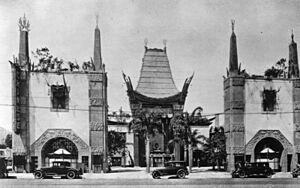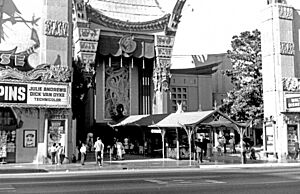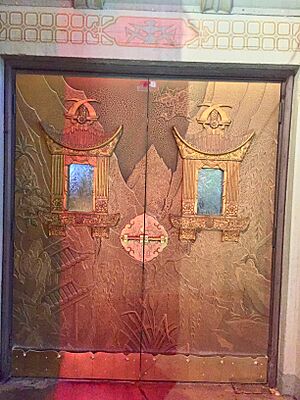Grauman's Chinese Theatre facts for kids
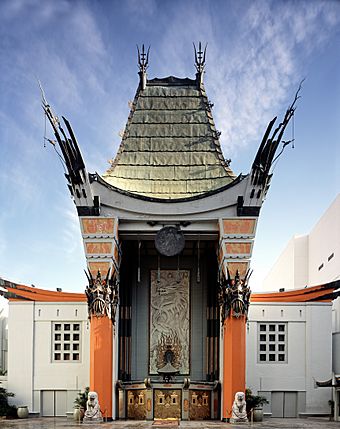
The forecourt entrance, Hollywood Boulevard
|
|
| Former names |
|
|---|---|
| Address | 6925 Hollywood Boulevard Hollywood, California, US |
| Coordinates | 34°6′7″N 118°20′27.5″W / 34.10194°N 118.340972°W |
| Public transit | |
| Owner | Chinese Theatres, LLC |
| Type | Indoor movie theater |
| Capacity | 932 (as of 2013) |
| Construction | |
| Broke ground | January 9, 1926 |
| Built | January 16, 1926 |
| Opened | May 18, 1927 |
| Renovated |
|
| Architect | Raymond M. Kennedy, employee of Meyer and Holler |
| Designated: | June 5, 1968 |
| Reference #: | 55 |
| Designated: | April 4, 1985 |
| Part of: | Hollywood Boulevard Commercial and Entertainment National Historic District |
| Reference #: | 85000704 |
The TCL Chinese Theatre is a famous movie theater in Hollywood, California. It's known for its unique Chinese-style design. You can find it on the Hollywood Walk of Fame.
This special theater was built after the success of the nearby Grauman's Egyptian Theatre. Both theaters have an "Exotic Revival" style, meaning they look like buildings from other cultures.
The Chinese Theatre opened on May 18, 1927. It showed the movie The King of Kings first. Since then, many famous movies have had their premieres here, including Star Wars in 1977.
One of the coolest things about the theater is its front courtyard. Here, you can see concrete blocks with the handprints, footprints, and signatures of many movie stars. These prints date from the 1920s to today.
The theater was first called Grauman's Chinese Theatre. In 1973, it became Mann's Chinese Theatre. Then, in 2001, it went back to its original name. In 2013, a company called TCL bought the right to have their name on the theater. That's why it's now called the TCL Chinese Theatre.
In 2013, the theater was updated to become a special IMAX movie theater. It now has one of the biggest movie screens in North America.
Contents
History of the Chinese Theatre
How the Theater Started
In 1923, some important people in Hollywood, like Sid Grauman, Mary Pickford, and Douglas Fairbanks, talked about building a new theater. They first thought it would be for plays, with movies shown only sometimes. But movies became very popular, so they decided to make it a movie theater instead.
Sid Grauman was a big theater owner. He had already built the Million Dollar Theater and the Egyptian Theatre. In 1925, he found a spot on Hollywood Boulevard for his new theater. It was where actor Francis X. Bushman's house used to be. A special plaque was put on the theater to thank Bushman.
The company Meyer & Holler designed the Chinese Theatre. Raymond M. Kennedy was the main architect. They wanted it to look like a grand "palace." Early reports said it would cost $5 million, but it actually cost $2.1 million to build. Grauman owned the theater with Mary Pickford, Douglas Fairbanks, and others.
The building started on January 5, 1926. Many celebrities were there, like Charlie Chaplin and Norma Talmadge. Norma Talmadge and Anna May Wong used a gold shovel to dig the first dirt. Anna May Wong also put the first rivet into the building.
The Famous Handprints
During construction, Sid Grauman hired Jean Klossner to make the concrete in the front courtyard very strong. Klossner later became known as "Mr. Footprint." He helped with the handprint ceremonies for many years.
There are different stories about how the handprint tradition began. One story says that Norma Talmadge accidentally stepped into the wet concrete. Another story from Sid Grauman himself says he accidentally stepped in wet concrete. He then asked Mary Pickford to put her foot in it too.
Jean Klossner also said that he and Grauman came up with the idea together. Klossner's own handprint and signature from 1927 are still there today. Douglas Fairbanks was the second celebrity to leave his prints.
In 1929, Grauman sold his share of the theater. But he came back to manage it for the premiere of Hell's Angels. He retired again but returned on Christmas Day 1931 and stayed until he passed away in 1950.
Continuing Success
The Chinese Theatre hosted the Academy Awards ceremonies in 1944, 1945, and 1946. These awards are now held at the Dolby Theatre next door.
The theater is famous for its beautiful inside design. In 1952, John Tartaglia became the head interior decorator. He also continued the tradition of the footprint ceremonies.
Tartaglia did his first ceremony for Jean Simmons in 1953. This was for the premiere of The Robe, the first movie shown in CinemaScope. Tartaglia continued this work for 35 years, with his last ceremony for Eddie Murphy in 1987.
Keeping the Theater Special
The Chinese Theatre was named a historic landmark in 1968. It has been restored many times since then. Ted Mann, who owned Mann Theatres, bought it in 1973. It was called Mann's Chinese Theatre until 2001.
In 1984, the theater became part of the National Register of Historic Places. This helps protect its history.
Over the years, the theater has had different owners. In 2000, a plan was made to restore and update the building. This included making it stronger against earthquakes and adding new sound and projection systems. The original name, "Grauman's Chinese Theatre," was brought back.
In 2011, a company called Chinese Theatres LLC bought both Grauman's Chinese Theatre and the nearby Mann Chinese 6. The Chinese Theatre was sold for $25 million in 2013. Today, it is still a popular place to see new movies.
Theater Design
Outside the Theater
Raymond M. Kennedy designed the Chinese Theatre for Sid Grauman. The design is called "Exotic Revival" style. It cost $2.1 million to build, which was a lot for a movie theater back then.
The most noticeable part of the outside is the 90-foot-tall pagoda in the front. It has two big red pillars and a bronze roof. There are many Chinese decorations, like a 30-foot-tall stone dragon carving. Two Ming dynasty-era guardian lion statues stand at the entrance. These statues and other items were brought from China. Chinese artists helped create the traditional decorations.
Inside the Theater
The main movie room has a large, fancy design on its ceiling. It looks like a doily with silver dragons and gold circles. A bronze chandelier shaped like a lantern hangs from the middle. The theater's colors are mostly red, with bronze, gold, and silver accents.
When it first opened, the stage was very large. It could be moved down into a pit to quickly change sets for live shows. The theater even had its own power plant!
The theater could hold 2,258 people when it first opened. This was about half the size of other big movie palaces at the time. It didn't have a large balcony for general seating. Instead, it had four private box suites.
The Chinese Theatre was the first commercial movie theater to have air conditioning. The vents are hidden behind the decorative pillars. It also had a hidden Wurlitzer organ. The organ's sound came from above the stage, making it sound like it was "descending from the heavens." The organ was removed in 1957.
At first, Sid Grauman didn't want to sell snacks because he thought it would take away from the movie experience. But the theater started selling concessions in the 1930s.
Handprints of the Stars
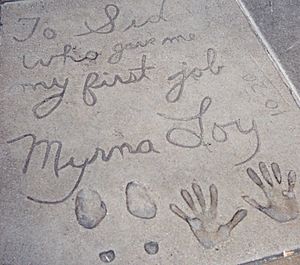
Almost 200 Hollywood celebrities have left their handprints, footprints, and signatures in the concrete of the theater's front courtyard. Douglas Fairbanks and Mary Pickford were the first to do this on April 30, 1927.
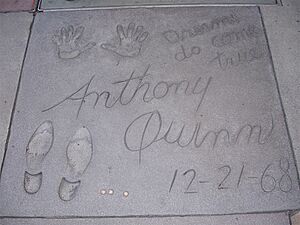
Some stars left unique imprints:
- Harold Lloyd left his eyeglasses.
- Groucho Marx left his cigar.
- Whoopi Goldberg left her dreadlock.
- The stars of Harry Potter left imprints of their wands.
- John Barrymore left his facial profile.
- Betty Grable left her leg print.
- Marilyn Monroe left her earring.
Western stars like William S. Hart and Roy Rogers left prints of their revolvers. John Wayne left his boot and fist prints. Even Herbie, a Volkswagen Beetle, left tire marks! The hoofprints of famous horses like Tom Mix's horse Tony, Gene Autry's horse Champion, and Roy Rogers' horse Trigger are also there.
Since 2011, many more concrete ceremonies have happened. Movie studios sometimes pay for these to help promote their films. Even with more ceremonies, a special committee still chooses which celebrities get to leave their prints in the main courtyard.
IMAX Conversion
In April 2013, the theater's owners announced plans to turn it into an IMAX theater. The new screen is 94 feet wide and 46 feet tall. It is curved and can be adjusted for different movies. To make sure everyone has a good view, the seats were changed to stepped rows.
The beautiful walls and ceiling inside the theater were kept the same. The theater reopened on September 20, 2013, with the IMAX 3D version of The Wizard of Oz. It first used a digital projection system. Later, a special 70mm IMAX projection system was added for movies like Interstellar and Oppenheimer. Because Oppenheimer was so popular, the 70mm system was kept for other films like Tenet and Dune: Part Two in 2024.
In April 2015, the IMAX system was upgraded again to use a new laser projector system. This was for the premiere of Furious 7.
Recreations of the Theater
You can find copies of the Chinese Theatre in other places:
- A full-size copy of the outside and lobby is at Disney's Hollywood Studios theme park in Florida. It used to have a ride called The Great Movie Ride. Now, it has the Mickey & Minnie's Runaway Railway ride. This copy also has concrete handprints from 1988–1995.
- A smaller copy of the Chinese Theatre, both inside and out, is at Parque Warner Madrid theme park in Spain. This building shows movies from Warner Bros..
See also
 In Spanish: Grauman's Chinese Theatre para niños
In Spanish: Grauman's Chinese Theatre para niños
- List of Grauman's Chinese Theatre handprint ceremonies
- List of Los Angeles Historic-Cultural Monuments in Hollywood
Images for kids
-
A Ming dynasty Guardian Lion statue outside Grauman's Chinese Theatre



